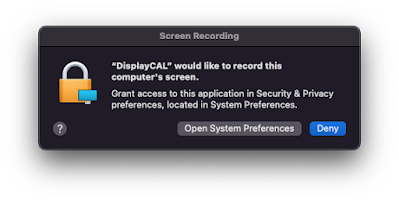Since I upgraded to a silicon Mac M1, the Mac mini 2020, with macOS Monterey, I had to calibrate my dual monitors using DisplayCal. Only it would not work.
After searching for an answer, I found this very helpful post on Macrumors forum by user divinebaboon. Lovely name.
I ran my own experiment and it worked. Very similar to what's described in the post above, with a few differences.
I have one monitor connected via HDMI and a second monitor connected to a USB3 Type-C to HDMI hub. Both monitors are Viewsonic VX2370, OK for my use, not the best monitors around certainly. I'm using XRite i1 Display Pro puck for measurement.
Here is how I did it:
1) Download the current DisplayCal App at https://displaycal.net/#download. I got the "For Mac OSX (10.6 or newer), click on "Installer Package".
It brings you to a SourceForge page and downloads DisplayCal v. 3.8.9.32) Install DisplayCal. It will show a window to allow DC to record your monitor, open System Preferences and allow it.
3) Plug your measuring device, start DisplayCal. It will prompt you to install the latest Argyll library. Do it, it will download an older version V2.1.2 as mentioned in the post. Quit DC.
4) Go to: https://www.argyllcms.com/downloadmac.html and download the latest executables. In my case v2.3.0
5) Untar the Argyll package with Unarchiver or your app of choice. It will look like this:
6) Go to: User/Library/Application Support/DisplayCal, and look into the "dl" folder. You will see the Argyll_V2.1.2 folder. Trash it and Empty Trash.7) Move the Argyll_V2.3.0 folder into this dl folder. It should now look like this:
8) Restart DisplayCal, if it asks again for the Argyll Library, click on File/Locate ArgylCMS executables, and point it at the bin folder.
9) Start calibration. macOS will complain multiple times about Argyll executables that cannot be opened because the developer cannot be identified. Each time this happens, go to the Argyll_2.3.0/bin folder and manually open each executable by right-clicking on it. Then click on the alert Cancel button.
Here is an example with "iccgamut":
Right-clicking on iccgamut forces run the executable in Terminal:Click Cancel only after Terminal is running the executable and the process is completed.
10) You have to do this each time macOS blocks an executable and it happens at different times during the calibration which lasted 9min. in my case. Eventually it goes through it all. Next time macOS should not block the executables, but if it does, employ the same technique.
11) On reboot DisplayCal sees both monitors just fine:
VX2370 (1) and (2) detected.
12) In my case I set the (Pre) Calibration Whitepoint to 6500K, White Level to 120cd/m2, and Tone Curve to Gamma 2.2 in DisplayCal.
I reset the monitors completely, switch the color profile from Native to User Color and adjust the RGB settings and the brightness setting to optimize them in the Interactive Display Adjustment. I do not adjust anything else in the monitors.The VX2370 is not a performance monitor. I only just adjust the Colors and Brightness to be in the target ranges, I leave every other monitor settings to default.13) The calibration goes through its paces. Click on Install profile and you are done. Do the same for the second monitor. Success!
One more thing: Sometimes DisplayCal freezes after the Install Profile, just force quit. Also randomly, one or both monitors will black-out when closing DisplayCal windows, like the Interactive Display Adjustment window. Just unplug and replug the HDMI cable and the signal will come back.
If you can, please contribute to the development of DisplayCal.















